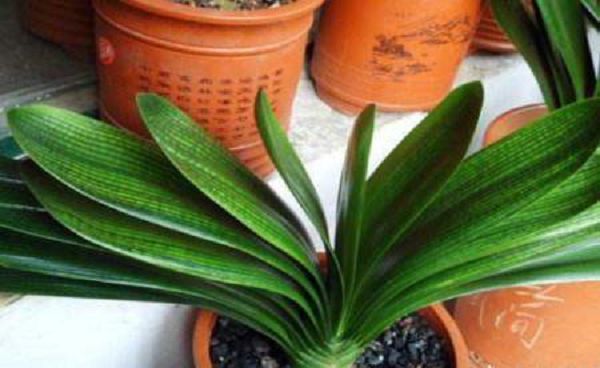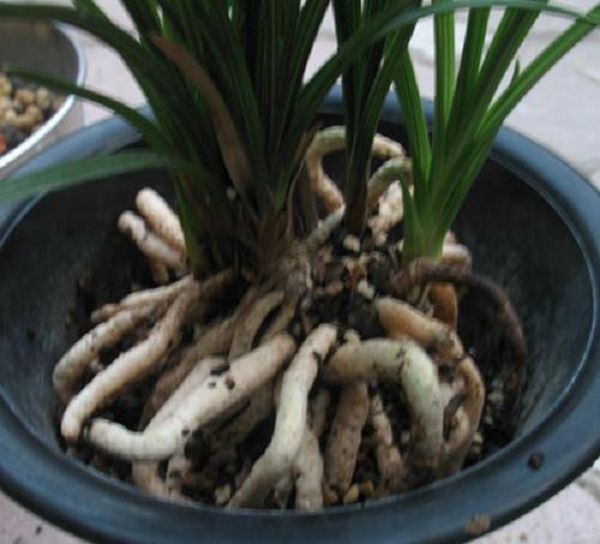Cultivation and maintenance of Cymbidium
The leaves, flowers and fruits of the gentleman's orchid are beautiful, especially the huge leaves are green all the year round, graceful, noble and dignified. When blooming, green leaves and red flowers contrast each other, gorgeous flowers and colors, gorgeous but not demon, elegant demeanor, more eye-catching and moving, is the flowers and leaves and appreciation of potted flowers. Especially when the flowers are in full bloom during the Spring Festival, they are deeply welcomed by urban and rural residents and become a good product for decorating halls, meeting halls or decorating rooms.
2. Ecological habits
The base of Magnolia grandiflora is a pseudobulb formed by leaf base. Leaves are distichous, broad-banded, top round and obtuse, entire, hard, thick and shiny. Flowering stems erect, flattened, ca. 30-40 cm tall. Umbels terminal, with several imbricate bracts. Florets several to dozens, funnel-shaped. Perianth lobes 6, connate, orange outside, yellowish inside. Berries globose, flowering between spring and summer. The smiling gentleman orchid has slightly drooping flowers and a narrow funnel-shaped perianth, which is smaller than the previous species. There are many varieties of orchid horticulture, the top-grade orchid is more than 9cm wide, the leaf color is bright, the leaf posture is erect, the leaf tip is round and obtuse, the vein is obviously raised, the leaf is thick, the inflorescence is stout and round, the flower is large, and the number of flowers is large and bright. Such as the great victory, dyeing factory, oil craftsman Lao Chen, and victory, Huang technician short leaf monk, round head, holding head monk, spring city short leaf and so on.
Native to southern Africa. I like half yin. I'm afraid of bright light. Like warm and cool climate. A slightly acidic soil with fertile, loose and good permeability is required.
3. Main points of cultivation.
(1) Basin soil
When potted, choose sand and peat or sand and rotten leaf soil. The basin of the adult seedling should be changed every 2 ~ 3 years, and the size of the basin is determined according to the seedling. Change the soil when changing the basin, and retting at the same time with cake fertilizer, barnyard manure, etc., in order to promote the rapid growth of Magnolia.
(2) watering
The gentleman orchid likes the warm and humid environment, its fleshy roots are well developed, and it has a certain ability to withstand drought, but it is afraid of waterlogging, and it is necessary to master the principle of humidity between dryness and wetness when watering. It is best to keep the relative humidity of the soil at 80%-90%, not less than 60%. Wash the leaf surface with tea water every week to make the leaf surface fresh and bright. In short, the four seasons as long as the spring bogey wind, summer sunscreen, autumn rain, winter is not dry to maintain exuberant plant growth, luxuriant flowers and leaves.
(3) fertilization
Magnolia can be fertilized after 1 month of slow seedling, fertilize and water once in 10-15 days, and stop application in summer. Half a month before the arrival of the two growth peaks in spring, it is appropriate to apply dried bean cakes or chicken dung in the basin, but not too close to the root, so as not to hurt the root. After autumn begins to conceive buds and blossom, it is necessary to increase the application of phosphate fertilizer to make the flowers big and colorful, and can prevent the occurrence of arrows. When applying fertilizer, do not pour it on the leaves or in the leaf sheath. If the fertilizer is not enough, the leaves are not glossy, the flowers are few and small, and there will be the phenomenon of blooming every other year. Regular topdressing is generally carried out in spring and autumn, but less in summer and winter.
(4) Lighting
The leaves of Magnolia are broad, according to a certain shade-tolerant, like semi-shade environment, the leaves of plants growing in 50% light transmittance environment are green and green, which can greatly improve the ornamental effect. The light will also affect the arrangement direction of the leaves of Cymbidium. On one side, the leaves that were originally arranged in a shape will be confused, resulting in a decline in ornamental effect, so we should pay attention to let the plants receive light evenly and rotate the direction of the basin regularly.
(5) temperature
The suitable temperature of Cymbidium is 15-20 ℃. When the plant growth is higher than 25 ℃, the plant growth is poor, and the excessive growth of leaves often occurs, which affects the flower bud differentiation. At this time, attention should be paid to ventilation and cooling; when it is lower than 10 ℃, the growth is slow; when it is below 0 ℃, the plant will freeze to death. Attention should be paid to cooling in summer, which can promote flower bud differentiation. The temperature difference between day and night is large, which is beneficial to the growth of Cymbidium, and the suitable temperature is 6-10 ℃.
- Prev

When should the gentleman orchid change the basin? Pinch the right time and hold back the flower buds
When should the gentleman orchid change the basin? Pinch the right time and hold back the flower buds
- Next

The plastic foam block on the bottom of the orchid pot will have an unexpected effect.
The plastic foam block on the bottom of the orchid pot will have an unexpected effect.
Related
- Is the orchid suitable for indoor use? Is it good for the body?
- How to prevent the empty root of orchids?
- What to do after the crab claw orchid is withered?
- Why are the leaves of orchids always yellow? Fertilizing and watering.
- Can the root of the gentleman orchid be saved if it is rotten?
- Diagnosis and treatment of cotton-blowing beetle insects in Cymbidium
- There is a way for a gentleman's orchid to rot.
- What is the most suitable temperature and humidity for the orchid?
- How to raise a gentleman's orchid? Cultivation techniques of Cymbidium
- How to prepare the nutritive soil for the cultivation of Cymbidium

